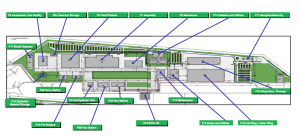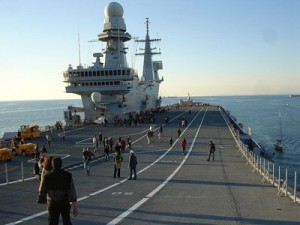2013-11-08 By Robbin Laird
Upon returning to the United States from Europe, I had a chance to reflect back on my visit to Italy and the discussions, which I had with senior officials about their approach to the F-35.
I was able to do so with Rear Admiral Covella, the head of the F-35 program in Italy during his visit to the United States.
The Admiral underscored that his office was unique in the Italian MOD in that it brought together various elements of the Italian engagement in the F-35 program. He was responsible not only for the acquisition of the plane but of shaping the infrastructure for the standup of the program as well.
The idea was to pull together in one single organization all of the activities related to F-35 in Italy.
We deal with various aspects of the program, including the security of the program, Italian industrial participation in the program, the logistics of the program, and when we discuss logistics we are also discussing the building of the infrastructure at the Italian bases.
We have several bases where the F-35 will be located: Amendola and a second ITAF MOB, for the CTOL variant, and the Navy base at Grottaglie, where both the Air Force and Italian F-35Bs will be located.
The base of Decimomannu, served by the ACMI range, will be also readied for F-35 as “Deployment Operating Base.”
The Cavour will see some changes as well; there are no structural changes necessary but some adaptations such as dedicated secure networks and laying down a new type of surface treatment for the ship flight deck.
As I wrote in an earlier piece, the size and scope of the FACO facility in Italy was a surprise.
It was more of an F-35 campus, than being a final assembly facility. And the Italian approach to the campus as a coalition engagement facility was also evident.
It was evident as well, that the most cost effective approach one might take, was to build out the infrastructure for expansion from the outset rather than just building a narrowly conceived final assembly facility and then later adding capability.
It is exactly that.
It was built with the objective to be a complete MRO&U facility when the production run is finished in the mid-2020s.
It is set up to top up at 2 aircraft build for month.
After that the FACO will be available in full to function as an F-35 MRO facility.
The facility is already established to transition this way.
There is the ATF facility and the final paint facility built on the FACO grounds.
There will be a reshaping of the FACO when the production run is completed but as you noted the overall facility is already in place to provide for an MRO&U capability for the F-35 even during the production run.
We will be able to perform MRO and upgrade on the aircraft, verify the low observability and provide a final paint capability as well.

It is clear as well that MRO for the F-35 is really about combat sustainment.
The Cameri facility is well located to support activity in the region as well, where operational dynamics will very likely be significant.
There are two observations which can be made about Cameri.
It already is state of the art MRO&U site for the Italian Air Force.
It maintains the Eurofighter and Tornado for the Air Force.
It is well located in terms of airports and ports as well to support the facility.
There is space as well for expansion.
And when the Tornado stands down, its current facilities will then be available for F-35 to use.
This means that the services which the facility can provide can expand over time as well.
I argued earlier as well that the F-35 C could be maintained as well at Cameri.
Question: What is the possibility for the F-35 C being maintained at Cameri, given the operational engagement of the USN in Italy?
We believe so.
It is up to the USN, but the study which we did prior to building the Cameri facility clearly underscored that the facility can be rigged up to do all three variants of the F-35 from a sustainment point of view.
The head of the Italian Air Force had underscored during his interview that the 60/40 split between the As and Bs was being done because the Air Force saw the need for expeditionary flexibility. “We want to go to the mission, not the airfield.”
What is your view of how the Italian Navy and Air Force will evolve in their use of the B, especially because they will be based at the same facility?
Commonality is a great way to go forward in the future.
There will be two squadrons of Bs, one for the Navy and one for the Air Force.
The missions are different.
The Air Force is focused on expeditionary use of the aircraft and will focus on its ability to operate off of short airfields in operations to be closer to the action, so to speak.
The Navy is focused on the way we use carriers.
We do not use the carrier as the US does; we do not deploy for 6 months at a time.
We need to go out and be ready to go without a significant build up time. We look at the F-35B as providing a more capable ramp up capability for the Cavour.
The two competencies are different.
The Navy is focused on the ability to operate rapidly during the carrier’s operation in fleet activities as the main “ship weapon system”; the Air Force is focused on a specialized expeditionary operational focus.
USMC F-35B pilots, some of whom are Harrier pilots, have emphasized that an impact of the B versus the Harrier is a reduction of time necessary to recertify pilots during an operational period.

The point made is that after performing a mission, the Harrier pilots would then – because of the complexity of flying the aircraft – need time to do some flying to recertify their flying skills.
It has been emphasized that the B will dramatically reduce the need to do so, and enhance provide for more mission time with regard to the planes aboard the small deck carrier.
The Admiral agreed to this point and elaborated.
I am a Harrier pilot.
Your point is well taken.
We expect to get more mission time out of the F-35B than we have been able to get out of the Harrier.
If you cut out the recertification time necessary for the Harrier pilots, then the B will allow you more mission time.
When I was on the WASP, the pilots made it clear that the B was much easier to fly. And when the aircraft lands it is very stable.
Finally, I asked the Admiral what the advantage of having a coalition aircraft like the F-35 available to a future coalition of the willing?
All the aircraft can do the same range of missions.
Currently, you use your assets on a task-oriented basis; with the F-35 you can consider the coalition aircraft as a combined team.
And with the common flow of parts and procedures to the fleet of coalition aircraft allows for greater operational possibilities as well.
And the common symbology of the cockpit is significant as well in terms of sharing operational information for common operations.
For additional stories on the Italians and the F-35 see the following:
https://sldinfo.com/lessons-learned-at-cameri-their-implications-for-asia/
https://sldinfo.com/cameri-and-the-f-35-building-out-a-new-manufacturing-facility/
https://sldinfo.com/an-update-from-cameri-on-the-cameri-f-35-campus-october-2013/
https://sldinfo.com/building-out-an-f-35-fleet-sustainment-center-in-italy/
https://sldinfo.com/another-aspect-of-f-35-culture-change-building-out-the-cameri-facility/
https://sldinfo.com/visiting-the-italian-air-ministry/
https://sldinfo.com/re-thinking-the-role-of-the-smaller-deck-carrier-the-case-of-cavour/
An earlier versions of the lessons learned piece appeared as well on Breaking Defense as well.
http://breakingdefense.com/2013/11/lessons-learned-at-cameri-italys-f-35-hq-implications-for-asia/
For a look at synergies among the operators of the F-35 B see the following briefing slides:


